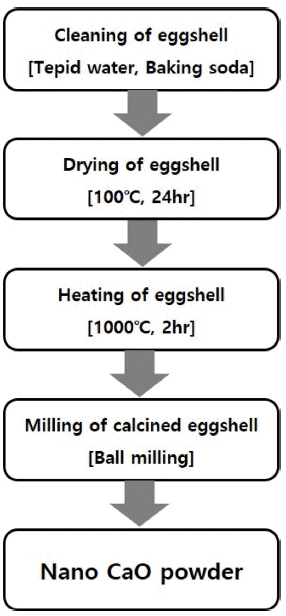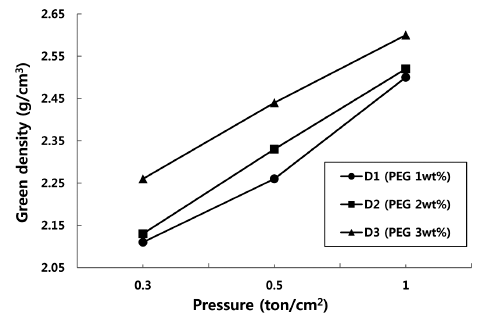Search
- Page Path
- HOME > Search
- [Korean]
- Optical Properties of Spherical YAG:Ce3+ Phosphor Powders Synthesized by Atmospheric Plasma Spraying Method Appling PVA Solution Route and Domestic Aluminium Oxide Seed
- Yong-Hyeon Kim, Sang-Jin Lee
- J Powder Mater. 2023;30(5):424-430. Published online October 1, 2023
- DOI: https://doi.org/10.4150/KPMI.2023.30.5.424

- 695 View
- 3 Download
-
 Abstract
Abstract
 PDF
PDF YAG phosphor powders were fabricated by the atmospheric plasma spraying method with the spray-dried spherical YAG precursor. The YAG precursor slurry for the spray drying process was prepared by the PVA solution chemical processing utilizing a domestic easy-sintered aluminum oxide (Al2O3) powder as a seed. The homogenous and viscous slurry resulted in dense granules, not hollow or porous particles. The synthesized phosphor powders demonstrated a stable YAG phase, and excellent fluorescence properties of approximately 115% compared with commercial YAG:Ce3+ powder. The microstructure of the phosphor powder had a perfect spherical shape and an average particle s ize of a pprox imately 30 μm. As a r esult of t he PKG t est of t he YAG p hosphor p owder, t he s ynthesized phosphor powders exhibited an outstanding luminous intensity, and a peak wavelength was observed at 531 nm.
- [Korean]
- Synthesis of C3S, C2S, C3A Powders using Ultra-fine Calcium Oxide Powder Synthesized from Eggshell and Effect of C3A Content on Hardened Mixed Aggregates
- Heon Kong, Ki-Beom Kwon, Sang-Jin Park, Whyo-Sub Noh, Sang-Jin Lee
- J Korean Powder Metall Inst. 2019;26(6):493-501. Published online December 1, 2019
- DOI: https://doi.org/10.4150/KPMI.2019.26.6.493

- 780 View
- 12 Download
-
 Abstract
Abstract
 PDF
PDF In this work, ultra-fine calcium oxide (CaO) powder derived from eggshells is used as the starting material to synthesize mineral trioxide aggregate (MTA). The prepared CaO powder is confirmed to have an average particle size of 500 nm. MTAs are synthesized with three types of fine CaO-based powders, namely, tricalcium silicate (C3S), dicalcium silicate (C2S), and tricalcium aluminate (C3A). The synthesis behavior of C3S, C2S and C3A with ultra-fine CaO powder and the effects of C3A content and curing time on the properties of MTA are investigated. The characteristics of the synthesized MTA powders are examined by X-ray diffraction (XRD), field emission-scanning electron microscope (FE-SEM), and a universal testing machine (UTM). The microstructure and compressive strength characteristics of the synthesized MTA powders are strongly dependent on the C3A wt.% and curing time. Furthermore, MTA with 5 wt.% C3A is found to increase the compressive strength and shorten the curing time.
- [Korean]
- Effect of Organic Additives on Microstructure and Green Density of Zirconia Granules Using Water Solvent
- Ji-Hwan Jung, Sang-Jin Lee
- J Korean Powder Metall Inst. 2017;24(2):147-152. Published online April 1, 2017
- DOI: https://doi.org/10.4150/KPMI.2017.24.2.147

- 1,408 View
- 31 Download
- 2 Citations
-
 Abstract
Abstract
 PDF
PDF Spherical-type zirconia granules are successfully fabricated by a spray-drying process using a water solvent slurry, and the change in the green density of the granule powder compacts is examined according to the organic polymers used. Two organic binders, polyvinyl alcohol (PVA) and 2-hydroxyethyl methacrylate (HEMA), which are dissolved in a water solvent and have different degrees of polymerization, are applied to the slurry with a plasticizer (polyethylene glycol). The granules employing a binder with a higher degree of polymerization (PVA) are not broken under a uniaxial press; consequently, they exhibit a poor green density of 2.4 g/cm3. In contrast, the granule powder compacts employing a binder with a lower degree of polymerization (HEMA) show a higher density of 2.6 g/cm3 with an increase in plasticizer content. The packing behavior of the granule powders for each organic polymer system is studied by examining the microstructure of the fracture surface at different applied pressures.
-
Citations
Citations to this article as recorded by- Effects of TiO2 Addition and Processing Variables on the Properties of Black Aluminum Nitride
Min-Kwon Park, Sin-Il Go, Kwang-Hee Han, Sang-Jin Lee
Korean Journal of Materials Research.2025; 35(8): 345. CrossRef - Uniaxial compaction and sintering of ZrO2−3 mol% Y2O3 using rubber and PEG solutions as binders
M.I. Dvornik, O.O. Shichalin, E.A. Mikhailenko, A.A. Burkov, S.V. Nikolenko, N.M. Vlasova, E.V. Chernyakov, A.A. Gnidenko, P.G. Chigrin, I. Yu Buravlev, N.S. Konovalova
Materials Chemistry and Physics.2024; 328: 129981. CrossRef
- Effects of TiO2 Addition and Processing Variables on the Properties of Black Aluminum Nitride
- [Korean]
- Synthesis of YAG:Ce3+ Phosphor Powders by Polymer Solution Route and Alumina Seed Application
- Yong-Hyeon Kim, Sang-Jin Lee
- J Korean Powder Metall Inst. 2013;20(1):37-42.
- DOI: https://doi.org/10.4150/KPMI.2013.20.1.037

- 691 View
- 0 Download
- 4 Citations
-
 Abstract
Abstract
 PDF
PDF - YAG:Ce3+ phosphor powders were synthesized using a Al_2O_3 seed (average particle size: 5 µm) by the polymer solution route. PVA solution was added to the sol precursors consisting of the seed powder and metal nitrate salts for homogeneous mixing in atomic scale. All dried precursor gels were calcined at 500°C and then heated at 1400°Csim1500°C in N_2/H_2 atmosphere. The final powders were characterized by using XRD, SEM, PSA, PL and PKG test. All synthesized powders were crystallized to YAG phase without intermediate phases of YAM or YAP. The phosphor properties and morphologies of the synthesized powders were strongly dependent on the PVA content. Finally, the synthesized YAG:Ce3+ phosphor powder heated at 1500°C, which is prepared from 12:1 PVA content and has an average particle size of 15 µm, showed similar phosphor properties to a commercial phosphor powder.
-
Citations
Citations to this article as recorded by- Optimization of LiNiCoMnO2 Cathode Material Synthesis Using Polyvinyl Alcohol Solution Method for Improved Lithium-Ion Batteries
Ha Eun Kang, Tae Min Park, Sung Geun Song, Young Soo Yoon, Sang Jin Lee
Nanomaterials.2024; 14(13): 1096. CrossRef - Optical Properties of Spherical YAG:Ce3+ Phosphor Powders Synthesized by Atmospheric Plasma Spraying Method Appling PVA Solution Route and Domestic Aluminium Oxide Seed
Yong-Hyeon Kim, Sang-Jin Lee
journal of Korean Powder Metallurgy Institute.2023; 30(5): 424. CrossRef - Pulverization and Densification Behavior of YAG Powder Synthesized by PVA Polymer Solution Method
Hyun-Ho Im, Sang-Jin Lee
Korean Journal of Materials Research.2020; 30(11): 573. CrossRef - Effect of PVA Polymerization on Synthesis of YAG:Ce3+Phosphor Powders Prepared by a Solid-liquid Hybrid Route
A-Reum Kim, Sang-Jin Lee
Journal of the Korean Ceramic Society.2014; 51(5): 424. CrossRef
- Optimization of LiNiCoMnO2 Cathode Material Synthesis Using Polyvinyl Alcohol Solution Method for Improved Lithium-Ion Batteries
- [Korean]
- Characteristics of Spodumene Powders Synthesized by Polyvinyl Alcohol Solution Technique
- Sang-Jin Lee, Ji-Eun Park
- J Korean Powder Metall Inst. 2011;18(1):35-40.
- DOI: https://doi.org/10.4150/KPMI.2011.18.1.035

- 507 View
- 1 Download
- 2 Citations
-
 Abstract
Abstract
 PDF
PDF - LAS-system ceramic powder, spodumene (Li_2OcdotAl_2O_3cdot4SiO_2), was successfully synthesized by a chemical solution technique employing PVA(polyvinyl alcohol) as an organic carrier. The PVA content affected the microstructure of porous precursor gels and the crystalline development. The optimum PVA content contributed to homogeneous distribution of metal ions in the precursor gel and it resulted in the synthesis of glass free beta-spodumene powder having a specific surface area of 7.57;m2/g. The agglomerated beta-spodumene powders were also enough soft to grind to fine powders by a simple ball milling process. The microstructures of the densified powder compacts were strongly dependant on the minor phases of spodumene solid solution and amount of liquid phase, which were formed from the inhomogeneous precursors.
-
Citations
Citations to this article as recorded by- Pulverization and Densification Behavior of YAG Powder Synthesized by PVA Polymer Solution Method
Hyun-Ho Im, Sang-Jin Lee
Korean Journal of Materials Research.2020; 30(11): 573. CrossRef - Synthesis of YAG:Ce3+Phosphor Powders by Polymer Solution Route and Alumina Seed Application
Yong-Hyeon Kim, Sang-Jin Lee
Journal of Korean Powder Metallurgy Institute.2013; 20(1): 37. CrossRef
- Pulverization and Densification Behavior of YAG Powder Synthesized by PVA Polymer Solution Method
- [Korean]
- Phase Developments and Microstructure Changes of Calcium Phosphate Powders Synthesized by Recycling Eggshell
- Sang-Jin Lee, Joo-Won Kim
- J Korean Powder Metall Inst. 2004;11(5):391-398.
- DOI: https://doi.org/10.4150/KPMI.2004.11.5.391

- 361 View
- 0 Download
-
 Abstract
Abstract
 PDF
PDF - Calcium phosphate powders were successfully synthesized by using re-cycled eggshell and phosphoric acid. The crystallization behavior and powder morphologies of the synthesized powders were dependent on the starting condition of the eggshell, the mixing ratio and method of the eggshell and phosphoric acid, and calcination temperature. In general, beta-tricalcium phosphate was stably synthesized at about 900°C for 1h at each proper mixing ratio. And, the synthesized powders showed the similar microstructures to the morphology of original eggshell with uniform particle sizes. In this study, the calcium phosphate powders were synthesized with eggshell in various processing method. And their unique microstructures obtained from the eggshell were also. observed. The crystalline developments and microstructures of the synthesized powders were examined by X-ray diffractometer and scanning electron microscopy.
TOP
 KPMI
KPMI


 First
First Prev
Prev


